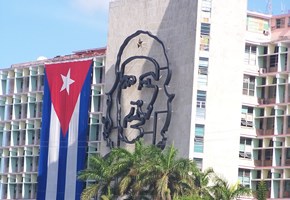Posted by Sudbury Northern Life Reporter Liz Fleming
"What have you seen of the island?" I asked the older couple,
sunning themselves poolside.
"Nothing," they replied. "We never leave the property."
I was stunned. There we were in Cuba, arguably one of the most
interesting areas of the Caribbean, and my two tanned friends
were content with a lounge chair and a pina colada.
Vacation time should be spent whatever way makes you happiest -
but, not exploring Cuba when you have the opportunity is, well,
a loss.
Cuba is a fascinating mix of the beach resort atmosphere of
places like Veradero, the full-on, Vegas-style glitz of the
famed Tropicana show in Havana, and the still very serious
official dedication to the heroes of the revolution. The latest
techno-pop tunes may blare in the resort discos, but in many
ways, time has stood still since the beginning of Castro's rule
in the 1950s. There are cars older than most of the tourists,
still in regular use. Not the treasured babies of automobile
aficionados, these cars are instead the basic means of
transportation for many Cuban families. Repaired for fifty
years, the cars are held together by wire, glue and
considerable faith.
But perhaps the most fascinating example of faith you'll
witness in Cuba is the on-going passion the country seems to
exude for Che Guevara - long dead, but still the most popular
figure of their revolutionary past. Born Ernesto Guevara in
Argentina, Che (which means 'friend' in Spanish) came to Cuba
as a doctor to serve with Castro, quickly rose to military
power and played a pivotal role in deposing the Fulgencio
Batista regime.
Assassinated in 1967, at the age of 39, while trying to lead
another revolution in Bolivia, Che is an iconic hero in Cuba.
In Havana's Revolution Square, the enormous side of one
building is adorned with a line drawing of his face while
billboards showing him and quoting his most stirring
revolutionary sentiments line the roadways. Every gift shop
offers Che postcards - his face is unmistakeable.
A visit to his memorial, just outside the town of Villa Clara,
is a fascinating study in both history and passion.
Regardless of your political views or your opinion of the man
himself, a tour of Che's possessions and the photographic
chronicle of his life will offer a rare glimpse into one of the
world's longest-standing love affairs between a leader and his
people.
A chess set, doctor's lab coat, a camera in its leather case,
even a photo of Che holding a baseball bat are displayed with
the kind of reverence reserved in other countries only for
religious artifacts. His camera is the only one you'll see.
Tourists and locals must leave theirs outside, to show proper
respect.
In an adjacent room is a tomb containing the remains of Che and
the small band of Cuban revolutionaries killed with him in
Bolivia and returned to Cuba 30 years later. Carvings of each
face surround the central image of their leader, identified
simply as Che. Visitors shuffle through the cool, candlelit
darkness in silence. Outside, cameras once more in hand,
tourists snap photos of the enormous statue atop the memorial.
It could be argued that, had he lived longer, Che's luster
might have dimmed in his adopted country. We'll never know - he
died young and has remained a cultural symbol for Cuba. Sitting
in the air-conditioned comfort of the Sunwing flight home, I
raise a glass, not to revolution, and not even to Che, but
rather to the timelessness of passion.
